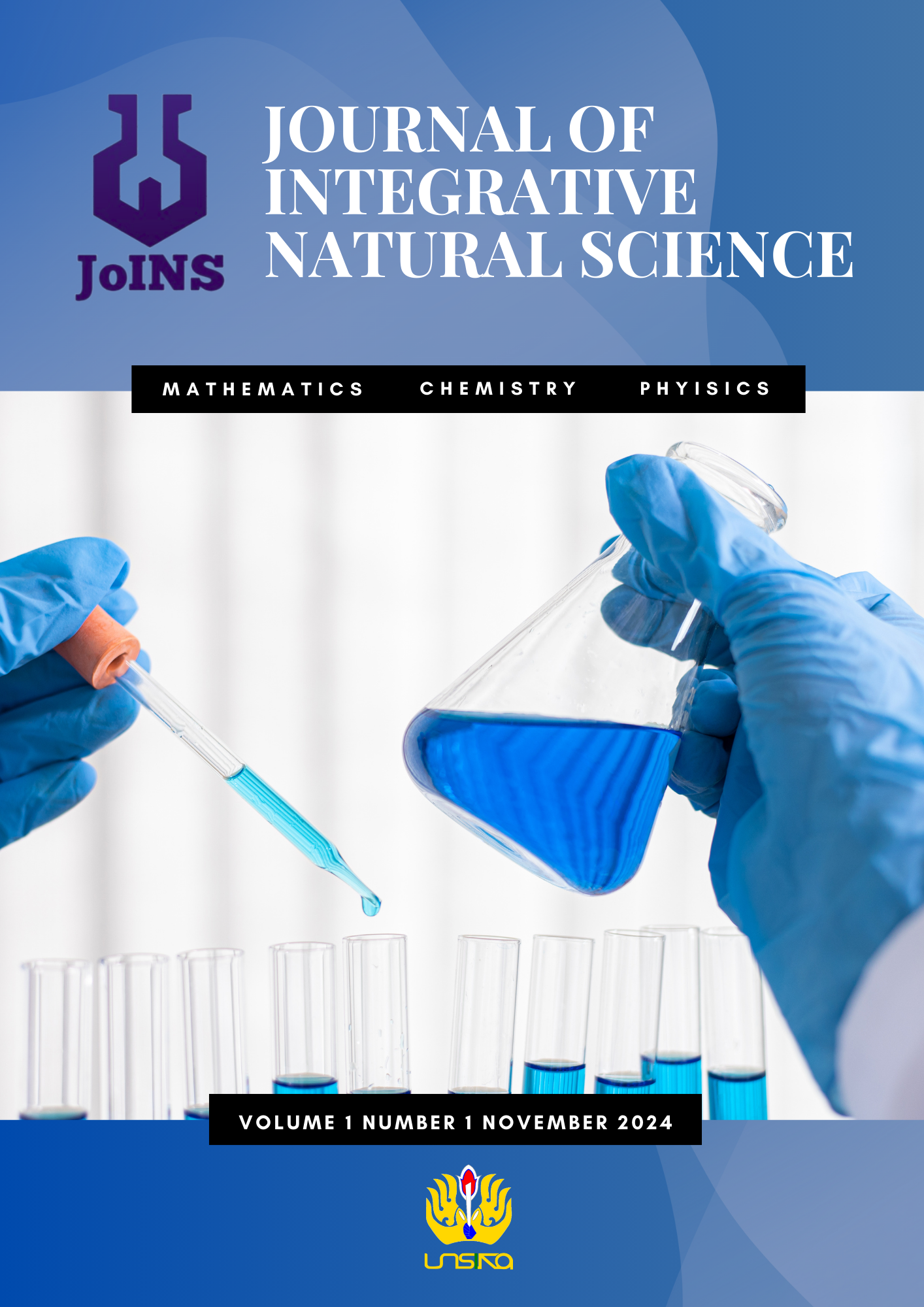Molecular Docking Metabolit Sekunder Bawang Putih (Allium Sativum) sebagai Antikanker Payudara: Pendekatan In-Silico
Keywords:
Kanker Payudara, NF-κB, Bawang Putih, In-SilicoAbstract
Breast cancer is the second biggest deadly disease after cardiovascular disease. Anticancer is growing from the use of synthetic materials to the use of natural ingredients. Excessive use of anticancer drugs causes cancer cell resistance to drugs. Nuclear Factor Kappa B (NF-κB) is a major signaling pathway involved extensively in cancer growth and metastasis. NF-κB can be used as a method to determined the anticancer properties of a compound. In-silico research was preliminary research that is useful for finding the best results to be done before in vitro and in vivo. The results of this study showed that the metabolite compound γ-glutamyl-phenylalanine was close to the Gibbs energy value of doxorubicin as a comparison ligand with a value of -7.2 kcal/mol. The γ-glutamyl-phenylalanine (γ-glu-phe) compound binded to crystal inducing kinases with hydrophobic bond types and pi bonds with γ-glu-phe. It could be concluded that the in-silico secondary metabolite of garlic that played a role in inhibiting cancer metastasis is γ-glu-phe
References
J. A. Malik et al., “Drugs repurposed: An advanced step towards the treatment of breast cancer and associated challenges,” Biomedicine and Pharmacotherapy, vol. 145, p. 112375, 2022, doi: 10.1016/j.biopha.2021.112375.
WHO, “Latest global cancer data: Cancer burden rises to 18.1 million new cases and 9.6 million cancer deaths in 2018,” lyon, 2003.
Ministry of Health, “Panduan Penatalaksanaan Kanker Payudara (Breast Cancer Treatment Guideline),” Jurnal Kesehatan Masyarakat, vol. 4, no. 4, pp. 1–50, 2019, [Online]. Available: http://kanker.kemkes.go.id/guidelines/PPKPayudara.pdf
anonim, “Penyakit Kanker di Indonesia Berada Pada Urutan 8 di Asia Tenggara dan Urutan 23 di Asia,” Direktorat Jendral Pencegahan dan Pengendalian Penyakit.
G. P. Gupta and J. Massagué, “Cancer Metastasis: Building a Framework,” Cell, vol. 127, no. 4, pp. 679–695, 2006, doi: 10.1016/j.cell.2006.11.001.
N. Amalina, I. P. Nurhayati, and E. Meiyanto, “Doxorubicin Induces Lamellipodia Formation and Cell Migration,” Indonesian Journal of Cancer Chemoprevention, vol. 8, no. 2, p. 61, 2017, doi: 10.14499/indonesianjcanchemoprev8iss2pp61-67.
C. Galeone et al., “Onion and garlic use and human cancer,” American Journal of Clinical Nutrition, vol. 84, no. 5, pp. 1027–1032, 2006, doi: 10.1093/ajcn/84.5.1027.
O. B. Jung et al., “Inhibition of cell growth and induction of apoptosis via inactivation of NF-κB by a sulfurcompound isolated from garlic in human colon cancer cells,” J Pharmacol Sci, vol. 104, no. 4, pp. 374–383, 2007, doi: 10.1254/jphs.FP0070789.
A. A. Ratnasari, H. Winarto, S. Purbadi, S. M. Sekarutami, and B. Sutrisna, “Hubungan Ekspresi NFκB dengan Respons Radiasi Kanker Serviks Stadium Lokal Lanjut,” eJournal Kedokteran Indonesia, vol. 4, no. 1, 2016, doi: 10.23886/ejki.4.5906.31-6.
Z.-Q. Liang et al., “Nuclear factor-κB-dependent cyclin D1 induction and DNA replication associated with N-methyl-D-aspartate receptor-mediated apoptosis in rat striatum,” J Neurosci Res, vol. 85, no. 6, pp. 1295–1309, May 2007, doi: https://doi.org/10.1002/jnr.21248.
F. D. Prieto-Martínez, M. Arciniega, and J. L. Medina-Franco, “Acoplamiento Molecular: Avances Recientes y Retos,” TIP Revista Especializada en Ciencias Químico-Biológicas, vol. 21, May 2018, doi: 10.22201/fesz.23958723e.2018.0.143.
A. N. O. Sebayang, “Efek Kardiotoksik Obat Kemoterapi Doxorubicin,” Jurnal Ilmiah Mahasiswa Kedokteran Indonesia, vol. 7, no. 1, pp. 1–5, 2021, doi: 10.53366/jimki.v7i1.387.
H. P. Keiss et al., “Garlic (Allium sativum L.) modulates cytokine expression in lipopolysaccharide-activated human blood thereby inhibiting NF-κB activity,” Journal of Nutrition, vol. 133, no. 7, pp. 2171–2175, 2003, doi: 10.1093/jn/133.7.2171.
G. E. S. Batiha et al., “Chemical constituents and pharmacological activities of garlic (Allium sativum L.): A review,” Nutrients, vol. 12, no. 3, pp. 1–21, 2020, doi: 10.3390/nu12030872.
D. H. Tjahjono and N. Hamzah, “Studi Hubungan Kuantitatif Struktur-Aktivitas, Fitur Farmakofor, dan Docking Molekuler Senyawa Turunan Pirazolo-[3,4-d]-pirimidin sebagai Inhibitor Mer Tirosin Kinase,” Acta Pharmaceutica Indonesia, vol. 38, no. 1, pp. 1–10, 2013.
T. Lestari, “Studi Interaksi Senyawa Turunan 1 , 3-Dibenzoiltiourea sebagai Ribonukleotida Reduktase Inhibitor,” Jurnal Farmasi Indonesia, vol. 7, no. 3, pp. 163–169, 2015.
A. N. Jain and A. Nicholls, “Recommendations for evaluation of computational methods,” J Comput Aided Mol Des, vol. 22, no. 3–4, pp. 133–139, 2008, doi: 10.1007/s10822-008-9196-5.
D. D. Agistia, H. Purnomo, M. Tegar, and A. E. Nugroho, “Interaksi Senyawa Aktif Dari Aegle marmelos Correa Sebagai Anti Inflamasi Dengan Reseptor COX-1 Dan COX-2,” Traditional Medicine, vol. 18, no. 2, pp. 80–87, 2013.
T. Kawai and S. Akira, “Signaling to NF-κB by Toll-like receptors,” Trends Mol Med, vol. 13, no. 11, pp. 460–469, 2007, doi: 10.1016/j.molmed.2007.09.002.
N. D. Amalina, M. Suzery, and B. Cahyono, “Mengungkap Potensi Metabolit Sekunder Tanaman Herbal Indonesia untuk Menghentikan Metastasis Kanker Payudara: Pendekatan in-silico,” Indonesian Journal of Chemical Science, vol. 9, no. 3, 2020.
R. Y. Utomo, M. Ikawati, and E. Meiyanto, “Revealing the Potency of Citrus and Galangal Constituents to Halt SARS-CoV-2 Infection,” MDPI, vol. 2, no. March, pp. 1–8, 2020, doi: 10.20944/preprints202003.0214.v1.
N. P. L. Laksmiani, N. L. P. Vidya Paramita, and I. M. A. G. Wirasuta, “In vitro and in silico antioxidant activity of purified fractions from purple sweet potato ethanolic extract,” Int J Pharm Pharm Sci, vol. 8, no. 8, pp. 177–181, 2016.
Downloads
Published
Issue
Section
License
Copyright (c) 2024 Journal of Integrative Natural Science

This work is licensed under a Creative Commons Attribution-ShareAlike 4.0 International License.
![]()
This work is licensed under a Creative Commons Attribution-ShareAlike 4.0 International License.





